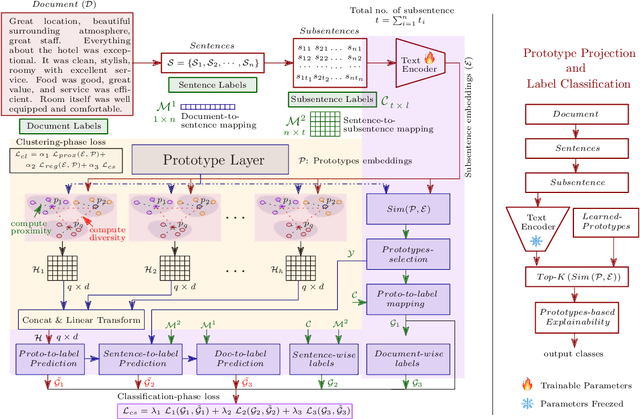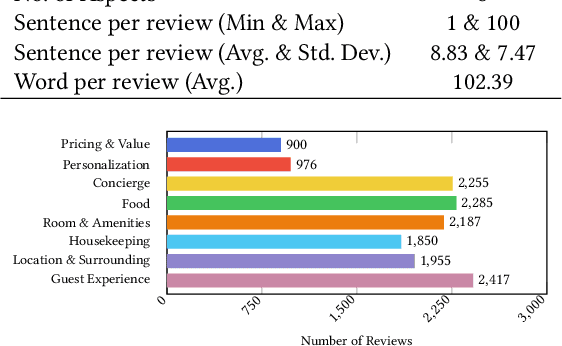Multi Label Classification
Multi-label classification is the task of assigning labels to entities where multiple labels may be assigned to each entity, allowing it to belong to more than one category simultaneously.
Papers and Code
MeisenMeister: A Simple Two Stage Pipeline for Breast Cancer Classification on MRI
Oct 31, 2025The ODELIA Breast MRI Challenge 2025 addresses a critical issue in breast cancer screening: improving early detection through more efficient and accurate interpretation of breast MRI scans. Even though methods for general-purpose whole-body lesion segmentation as well as multi-time-point analysis exist, breast cancer detection remains highly challenging, largely due to the limited availability of high-quality segmentation labels. Therefore, developing robust classification-based approaches is crucial for the future of early breast cancer detection, particularly in applications such as large-scale screening. In this write-up, we provide a comprehensive overview of our approach to the challenge. We begin by detailing the underlying concept and foundational assumptions that guided our work. We then describe the iterative development process, highlighting the key stages of experimentation, evaluation, and refinement that shaped the evolution of our solution. Finally, we present the reasoning and evidence that informed the design choices behind our final submission, with a focus on performance, robustness, and clinical relevance. We release our full implementation publicly at https://github.com/MIC-DKFZ/MeisenMeister
RL-AUX: Reinforcement Learning for Auxiliary Task Generation
Oct 27, 2025Auxiliary Learning (AL) is a special case of Multi-task Learning (MTL) in which a network trains on auxiliary tasks to improve performance on its main task. This technique is used to improve generalization and, ultimately, performance on the network's main task. AL has been demonstrated to improve performance across multiple domains, including navigation, image classification, and natural language processing. One weakness of AL is the need for labeled auxiliary tasks, which can require human effort and domain expertise to generate. Meta Learning techniques have been used to solve this issue by learning an additional auxiliary task generation network that can create helpful tasks for the primary network. The most prominent techniques rely on Bi-Level Optimization, which incurs computational cost and increased code complexity. To avoid the need for Bi-Level Optimization, we present an RL-based approach to dynamically create auxiliary tasks. In this framework, an RL agent is tasked with selecting auxiliary labels for every data point in a training set. The agent is rewarded when their selection improves the performance on the primary task. We also experiment with learning optimal strategies for weighing the auxiliary loss per data point. On the 20-Superclass CIFAR100 problem, our RL approach outperforms human-labeled auxiliary tasks and performs as well as a prominent Bi-Level Optimization technique. Our weight learning approaches significantly outperform all of these benchmarks. For example, a Weight-Aware RL-based approach helps the VGG16 architecture achieve 80.9% test accuracy while the human-labeled auxiliary task setup achieved 75.53%. The goal of this work is to (1) prove that RL is a viable approach to dynamically generate auxiliary tasks and (2) demonstrate that per-sample auxiliary task weights can be learned alongside the auxiliary task labels and can achieve strong results.
ProtoSiTex: Learning Semi-Interpretable Prototypes for Multi-label Text Classification
Oct 14, 2025



The surge in user-generated reviews has amplified the need for interpretable models that can provide fine-grained insights. Existing prototype-based models offer intuitive explanations but typically operate at coarse granularity (sentence or document level) and fail to address the multi-label nature of real-world text classification. We propose ProtoSiTex, a semi-interpretable framework designed for fine-grained multi-label text classification. ProtoSiTex employs a dual-phase alternating training strategy: an unsupervised prototype discovery phase that learns semantically coherent and diverse prototypes, and a supervised classification phase that maps these prototypes to class labels. A hierarchical loss function enforces consistency across sub-sentence, sentence, and document levels, enhancing interpretability and alignment. Unlike prior approaches, ProtoSiTex captures overlapping and conflicting semantics using adaptive prototypes and multi-head attention. We also introduce a benchmark dataset of hotel reviews annotated at the sub-sentence level with multiple labels. Experiments on this dataset and two public benchmarks (binary and multi-class) show that ProtoSiTex achieves state-of-the-art performance while delivering faithful, human-aligned explanations, establishing it as a robust solution for semi-interpretable multi-label text classification.
FedDEAP: Adaptive Dual-Prompt Tuning for Multi-Domain Federated Learning
Oct 21, 2025Federated learning (FL) enables multiple clients to collaboratively train machine learning models without exposing local data, balancing performance and privacy. However, domain shift and label heterogeneity across clients often hinder the generalization of the aggregated global model. Recently, large-scale vision-language models like CLIP have shown strong zero-shot classification capabilities, raising the question of how to effectively fine-tune CLIP across domains in a federated setting. In this work, we propose an adaptive federated prompt tuning framework, FedDEAP, to enhance CLIP's generalization in multi-domain scenarios. Our method includes the following three key components: (1) To mitigate the loss of domain-specific information caused by label-supervised tuning, we disentangle semantic and domain-specific features in images by using semantic and domain transformation networks with unbiased mappings; (2) To preserve domain-specific knowledge during global prompt aggregation, we introduce a dual-prompt design with a global semantic prompt and a local domain prompt to balance shared and personalized information; (3) To maximize the inclusion of semantic and domain information from images in the generated text features, we align textual and visual representations under the two learned transformations to preserve semantic and domain consistency. Theoretical analysis and extensive experiments on four datasets demonstrate the effectiveness of our method in enhancing the generalization of CLIP for federated image recognition across multiple domains.
Unifying and Enhancing Graph Transformers via a Hierarchical Mask Framework
Oct 21, 2025Graph Transformers (GTs) have emerged as a powerful paradigm for graph representation learning due to their ability to model diverse node interactions. However, existing GTs often rely on intricate architectural designs tailored to specific interactions, limiting their flexibility. To address this, we propose a unified hierarchical mask framework that reveals an underlying equivalence between model architecture and attention mask construction. This framework enables a consistent modeling paradigm by capturing diverse interactions through carefully designed attention masks. Theoretical analysis under this framework demonstrates that the probability of correct classification positively correlates with the receptive field size and label consistency, leading to a fundamental design principle: an effective attention mask should ensure both a sufficiently large receptive field and a high level of label consistency. While no single existing mask satisfies this principle across all scenarios, our analysis reveals that hierarchical masks offer complementary strengths, motivating their effective integration. Then, we introduce M3Dphormer, a Mixture-of-Experts-based Graph Transformer with Multi-Level Masking and Dual Attention Computation. M3Dphormer incorporates three theoretically grounded hierarchical masks and employs a bi-level expert routing mechanism to adaptively integrate multi-level interaction information. To ensure scalability, we further introduce a dual attention computation scheme that dynamically switches between dense and sparse modes based on local mask sparsity. Extensive experiments across multiple benchmarks demonstrate that M3Dphormer achieves state-of-the-art performance, validating the effectiveness of our unified framework and model design.
Instructions are all you need: Self-supervised Reinforcement Learning for Instruction Following
Oct 16, 2025Language models often struggle to follow multi-constraint instructions that are crucial for real-world applications. Existing reinforcement learning (RL) approaches suffer from dependency on external supervision and sparse reward signals from multi-constraint tasks. We propose a label-free self-supervised RL framework that eliminates dependency on external supervision by deriving reward signals directly from instructions and generating pseudo-labels for reward model training. Our approach introduces constraint decomposition strategies and efficient constraint-wise binary classification to address sparse reward challenges while maintaining computational efficiency. Experiments show that our approach generalizes well, achieving strong improvements across 3 in-domain and 5 out-of-domain datasets, including challenging agentic and multi-turn instruction following. The data and code are publicly available at https://github.com/Rainier-rq/verl-if
Fine-grained auxiliary learning for real-world product recommendation
Oct 06, 2025Product recommendation is the task of recovering the closest items to a given query within a large product corpora. Generally, one can determine if top-ranked products are related to the query by applying a similarity threshold; exceeding it deems the product relevant, otherwise manual revision is required. Despite being a well-known problem, the integration of these models in real-world systems is often overlooked. In particular, production systems have strong coverage requirements, i.e., a high proportion of recommendations must be automated. In this paper we propose ALC , an Auxiliary Learning strategy that boosts Coverage through learning fine-grained embeddings. Concretely, we introduce two training objectives that leverage the hardest negatives in the batch to build discriminative training signals between positives and negatives. We validate ALC using three extreme multi-label classification approaches in two product recommendation datasets; LF-AmazonTitles-131K and Tech and Durables (proprietary), demonstrating state-of-the-art coverage rates when combined with a recent threshold-consistent margin loss.
Instance Relation Learning Network with Label Knowledge Propagation for Few-shot Multi-label Intent Detection
Oct 09, 2025Few-shot Multi-label Intent Detection (MID) is crucial for dialogue systems, aiming to detect multiple intents of utterances in low-resource dialogue domains. Previous studies focus on a two-stage pipeline. They first learn representations of utterances with multiple labels and then use a threshold-based strategy to identify multi-label results. However, these methods rely on representation classification and ignore instance relations, leading to error propagation. To solve the above issues, we propose a multi-label joint learning method for few-shot MID in an end-to-end manner, which constructs an instance relation learning network with label knowledge propagation to eliminate error propagation. Concretely, we learn the interaction relations between instances with class information to propagate label knowledge between a few labeled (support set) and unlabeled (query set) instances. With label knowledge propagation, the relation strength between instances directly indicates whether two utterances belong to the same intent for multi-label prediction. Besides, a dual relation-enhanced loss is developed to optimize support- and query-level relation strength to improve performance. Experiments show that we outperform strong baselines by an average of 9.54% AUC and 11.19% Macro-F1 in 1-shot scenarios.
SpeechMLC: Speech Multi-label Classification
Sep 18, 2025



In this paper, we propose a multi-label classification framework to detect multiple speaking styles in a speech sample. Unlike previous studies that have primarily focused on identifying a single target style, our framework effectively captures various speaker characteristics within a unified structure, making it suitable for generalized human-computer interaction applications. The proposed framework integrates cross-attention mechanisms within a transformer decoder to extract salient features associated with each target label from the input speech. To mitigate the data imbalance inherent in multi-label speech datasets, we employ a data augmentation technique based on a speech generation model. We validate our model's effectiveness through multiple objective evaluations on seen and unseen corpora. In addition, we provide an analysis of the influence of human perception on classification accuracy by considering the impact of human labeling agreement on model performance.
Diffusion-Based Cross-Modal Feature Extraction for Multi-Label Classification
Sep 19, 2025Multi-label classification has broad applications and depends on powerful representations capable of capturing multi-label interactions. We introduce \textit{Diff-Feat}, a simple but powerful framework that extracts intermediate features from pre-trained diffusion-Transformer models for images and text, and fuses them for downstream tasks. We observe that for vision tasks, the most discriminative intermediate feature along the diffusion process occurs at the middle step and is located in the middle block in Transformer. In contrast, for language tasks, the best feature occurs at the noise-free step and is located in the deepest block. In particular, we observe a striking phenomenon across varying datasets: a mysterious "Layer $12$" consistently yields the best performance on various downstream classification tasks for images (under DiT-XL/2-256$\times$256). We devise a heuristic local-search algorithm that pinpoints the locally optimal "image-text"$\times$"block-timestep" pair among a few candidates, avoiding an exhaustive grid search. A simple fusion-linear projection followed by addition-of the selected representations yields state-of-the-art performance: 98.6\% mAP on MS-COCO-enhanced and 45.7\% mAP on Visual Genome 500, surpassing strong CNN, graph, and Transformer baselines by a wide margin. t-SNE and clustering metrics further reveal that \textit{Diff-Feat} forms tighter semantic clusters than unimodal counterparts. The code is available at https://github.com/lt-0123/Diff-Feat.
 Add to Chrome
Add to Chrome Add to Firefox
Add to Firefox Add to Edge
Add to Edge